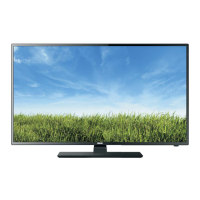
Do you have a question about the RCA RLDED4215A and is the answer not in the manual?
Warning about electric shock risk and not opening the unit.
Caution regarding battery replacement and potential explosion hazard.
Warning about procedures potentially leading to hazardous radiation exposure.
Warning to prevent fire or shock by avoiding rain, moisture, or liquid spills.
Warning that unauthorized modifications can void user authority.
Advise against using apparatus near water and blocking ventilation.
Warning against installation near heat sources like radiators or stoves.
Guidance on plug safety and consulting an electrician for outlet issues.
Instructions for protecting the power cord from damage.
Use specified accessories and exercise caution with carts to prevent tip-overs.
Advise to unplug during storms or long periods of non-use.
Refer all servicing to qualified personnel for any damage.
Ensure secure grounding pin connection to prevent electrical shock.
List of accessories included with the TV for checking.
Guidance on pointing the remote and effective operating distance.
Steps to open the battery door and insert batteries into the remote.
Advice on replacing weak batteries and handling battery types to avoid damage.
Detailed explanation of each button on the remote control and its function.
Identifies and explains the front panel components of the TV.
Identifies and explains the rear panel connection ports of the TV.
Identifies and explains the side panel buttons of the TV.
Guidance on connecting TV antenna, cable, or satellite systems.
Instructions for connecting A/V devices like VCRs or camcorders.
How to connect devices with composite video output (e.g., VCR, game system).
Steps to connect High-Definition sources using component video and audio cables.
Instructions for connecting High-Definition sources using HDMI cables.
Guide for connecting a computer to the TV using VGA and audio cables.
Instructions for connecting headphones and audio level advice.
Important safety precautions and guidelines for connecting the power cord.
How to connect to a home theater system for optimal audio performance.
Steps to configure digital audio output settings via the remote control.
Instructions for safely installing and removing the TV's base stand.
Guidelines for wall-mounting the TV using a VESA-compliant kit.
Advice on placing the TV on a stable surface away from hazards.
Steps for initial TV power-on and setup wizard initiation.
How to select the input source for the TV (e.g., TV, HDMI, PC).
Explains features within the Channel menu like Air/Cable, Auto Scan, and Channel List.
Details settings for Picture Mode, Brightness, Contrast, Color, Tint, Sharpness, and Advanced Settings.
Explains settings for Equalizer, MTS, Audio Language, Digital Audio Output, Surround Sound, and AVL.
Covers Sleep Timer, Time Zone, Daylight Saving Time, Time Format, Auto Clock, and Clock settings.
Describes Menu Language, Transparent, OSD Timeout, Closed Caption, Input Label, Other Settings, Restore Default, and Setup Wizard.
Explains features for changing password, system lock, US/Canada ratings, and RRT settings.
Lists resolutions, scanning frequencies, and formats supported for PC input.
Lists resolutions, scanning frequencies, and formats for Component and HDMI input.
Details about the TV panel, size, resolution, brightness, contrast, and viewing angles.
Information on color system, sound system, and audio output.
Lists and describes all input and output connection jacks on the TV.
Details on power requirement and rated power consumption.
Solutions for common TV issues like bad picture, no sound, or black and white display.
Troubleshooting for colored patches, unresponsive keys, hot panels, unusual dots, and stripes.
Solutions for unable to select channels and disordered display at power on.